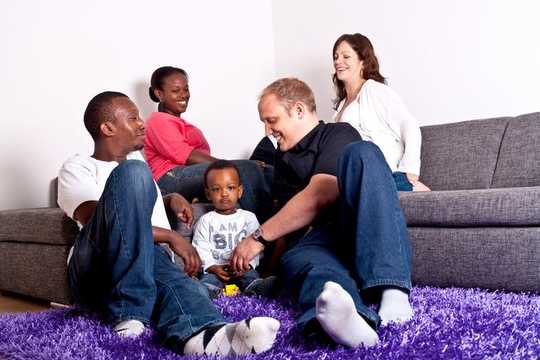
Although polyamorous families provide great support for themselves internally, they report experiencing marginalization within the health-care system and fear of judgment by health-care providers. (Shutterstock)
Polyamory is the act of engaging in multiple consensual, potentially long-term, romantic or sexual relationships at the same time.
We conducted an interview study with polyamorous families to examine their experiences with pregnancy and birth.
Our aim was to identify barriers to prenatal, antenatal and postnatal care for polyamorous families and to share results and strategies with health-care providers in the hope of overcoming them.
We found that those in polyamorous relationships benefit from each other but not from the system. Many of our interviewees expressed the view that having more partners garners more support.
They told us that although navigating multiple relationships can be difficult, it can also offer greater financial and logistical support when it comes to raising a family. One participant said:
“There’s extra one-on-one. When the 13-year-old middle child is sad and sick and whatever and just wants Momma, and the three-year-old just wants Dad… great, there’s still another adult to take care of those other kids.”
Our research participants also expressed difficulty navigating formal and informal social systems — including the health-care system — as we live in a world that tends to privilege monogamy.
A variety of relationship structures
The concept of polyamory, which is one type of non-monogamy, is poorly understood and it can mean different things to different people.
Generally speaking, polyamorous relationships are long-standing, romantic or sexual in nature, and involve more than two individuals. However, this is not true for everyone engaging in polyamory. There are a variety of relationship structures or “polycules” that exist within the world of polyamory.

Polyamory is an increasingly common relationship choice. (Shutterstock)
Some polycules are structured hierarchically where two individuals (or more) of similar (or different) gender identities live together (or separate) and prioritize their relationship but engage in other romantic or sexual relationships outside of this dyad.
Other polycules are non-hierarchical and all relationships are considered priority. In some cases, all individuals in a polycule are engaged in romantic or sexual relationships with all parties, but this is not always the case.
Each polyamorous relationship is unique in structure, arrangement and definition.
More common than people think
Because polyamory means different things to different people, it is a hard thing to quantify. All the participants in our study described being polyamorous as part of their identify. However, debate exists as to whether polyamory should be considered part of one’s sexual orientation or rather a relationship practice.
As such, prevalence estimates are also limited by individual willingness to disclose their polyamorous status.
The most recent estimate suggests that one in five single adults have practised some form of consensual non-monogamy.

Polyamorous research participants put a lot of effort into dialogue around family planning. (Shutterstock)
If only 10 per cent of these practise polyamory specifically, that would still represent two per cent of the entire single population.
Furthermore, this number does not account for married individuals engaging in consensual non-monogamy.
One Canadian based survey collected information from 547 self-identified polyamorous individuals. This survey reported that the number of polyamorous folks is growing. It also showed that the majority are of childbearing age (25 to 44 years) with greater than 20 per cent having at least one child under the age of 19.
Despite the limitations of research to date, we can conclude that polyamory is more common than most people think and that folks engaging in polyamorous relationships are having children.
Discussion of parenting roles
The polyamorous families we interviewed expressed a great deal of deliberateness in their decision-making, specifically around family planning.
They put substantial efforts into communication around whether children were desired within relationships, when to have children, who in the relationships would be biological parents and what parenting roles individuals would have.
Although this was not always the case, many of our interviewees also reported difficulty disclosing their polyamorous status due to fear of judgment. This was true for disclosure to family, friends, colleagues and, in the case of pregnancy and birth, to their care providers.
Even when participants did disclose their relationships with multiple partners, these relationships were not always validated. For example, one participant said:
“They asked who is allowed to make appointments for your child, and I said me, my husband and my girlfriend. And I had to give her name and her number. And they asked me several times, are you sure? What’s her relationship to the child? I’m like, well, I guess she’s technically his mother. And they’re like, well, we’ll just put down his aunt because we can’t put down multiple mothers when you already have a father, apparently.”
Marginalization within health-care system
Regarding pregnancy and birth, our participants expressed feeling marginalized in the health-care system. They found that health-care providers and the system in general offered little space to acknowledge partners outside of biological parentage.
Our participants expressed facing barriers such as lack of physical space for additional partners, lack of inclusion in medical decision making and facing judgement with disclosures.
Each experience that participants shared with us was unique, however, just as every family is.
About the Authors
Elizabeth Darling, Director/Assistant Dean, Midwifery, and Associate Professor, McMaster University; Erika Arseneau, Midwifery Student, McMaster University, and Samantha Landry, Student Midwife, McMaster University
This article is republished from The Conversation under a Creative Commons license. Read the original article.

Related Books:
The Five Love Languages: The Secret to Love That Lasts
by Gary Chapman
This book explores the concept of "love languages," or the ways in which individuals give and receive love, and offers advice for building strong relationships based on mutual understanding and respect.
Click for more info or to order
The Seven Principles for Making Marriage Work: A Practical Guide from the Country's Foremost Relationship Expert
by John M. Gottman and Nan Silver
The authors, leading relationship experts, offer advice for building a successful marriage based on research and practice, including tips for communication, conflict resolution, and emotional connection.
Click for more info or to order
Come as You Are: The Surprising New Science that Will Transform Your Sex Life
by Emily Nagoski
This book explores the science of sexual desire and offers insights and strategies for enhancing sexual pleasure and connection in relationships.
Click for more info or to order
Attached: The New Science of Adult Attachment and How It Can Help You Find—and Keep—Love
by Amir Levine and Rachel Heller
This book explores the science of adult attachment and offers insights and strategies for building healthy and fulfilling relationships.
Click for more info or to order
The Relationship Cure: A 5 Step Guide to Strengthening Your Marriage, Family, and Friendships
by John M. Gottman
The author, a leading relationship expert, offers a 5-step guide for building stronger and more meaningful relationships with loved ones, based on principles of emotional connection and empathy.























